Big Worlds On Small Screens & “Fantasy Films From the Eighties That Weren’t That Bad” — Rebecca Fisher Discusses “Time Bandits”
~ by Rebecca Fisher
If any film could be accurately described as containing everything but the kitchen sink, I’d stake my money on Time Bandits. You could describe it as a zanier episode of Doctor Who, or a slightly more child-friendly offering from Monty Python, or a mash-up of Roald Dahl and Douglas Adams – but its combination of dark comedy, time-travelling adventure and tongue-in-cheek musings on the nature of God and Evil make it truly unique.
Kevin is a young history buff with two parents that couldn’t care less, being glued every night to the television set and discussing the neighbours instead of paying the slightest bit of attention to their son. As a result, Kevin is more delighted than terrified when a band of dwarfs tumble out of his wardrobe, calling themselves “time bandits” and explaining they’ve got a map that leads them through time itself.
By leaping through time holes, they’re able to pull off heists without the slightest chance of being apprehended, greedily accumulating a fortune for themselves. The movie initially plays out like a series of vignettes, with Kevin and the dwarfs journeying to places such as Ancient Greece, Sherwood Forest and the Titanic, meeting the likes of Napoleon Bonaparte, Robin Hood and King Agamemnon along the way.
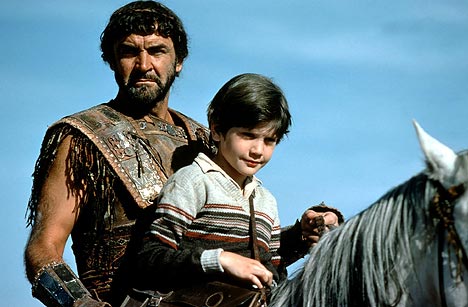 Kevin in a brief moment of happiness with King Agamemnon
Kevin in a brief moment of happiness with King Agamemnon
But there’s a catch. The dwarfs are the one-time servants of the Supreme Being, Creator of the Universe, who isn’t too impressed with what the runaways are up to. What’s more, a sinister figure known only as the Evil Genius watches the time-travellers from afar, coveting the map they carry so that he might remake the universe according to his own design.
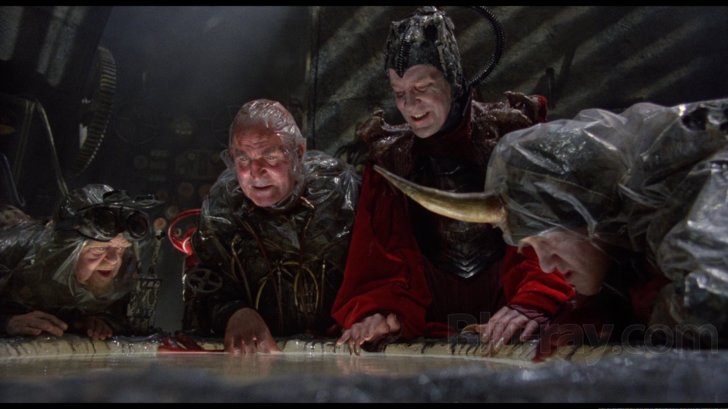 Evil and his minions watch the progress of Kevin and the Time Bandits
Evil and his minions watch the progress of Kevin and the Time Bandits
Written by Terry Gillam and Michael Palin (with the former directing and the latter in a small cameo) Time Bandits is an odd duck of a movie. As you’d expect from the writers, there’s a heavy dose of black humour and irreverence at work, with some dizzying questions raised only to be casually brushed aside. (On being asked why he created evil, the Supreme Being shrugs and says: “I think it’s something to do with free will.”)
As such it’s hard to know what to make of Time Bandits, or who exactly it’s for. Though the protagonist is a likeable child, the story has enough sharp edges to make younger viewers uneasy. There is no warm affection built up between Kevin and the dwarfs; he consistently disapproves of what they’re doing, and is resentful when they drag him away from a happy life as King Agamemnon’s adopted son. Neither is there any sort of reconciliation with Kevin’s parents: they ignore him at the start of the film, and they’re still ignoring him at its end. And though Kevin may desire an escape from his mundane life, his grand time-travelling adventure isn’t that much fun either.
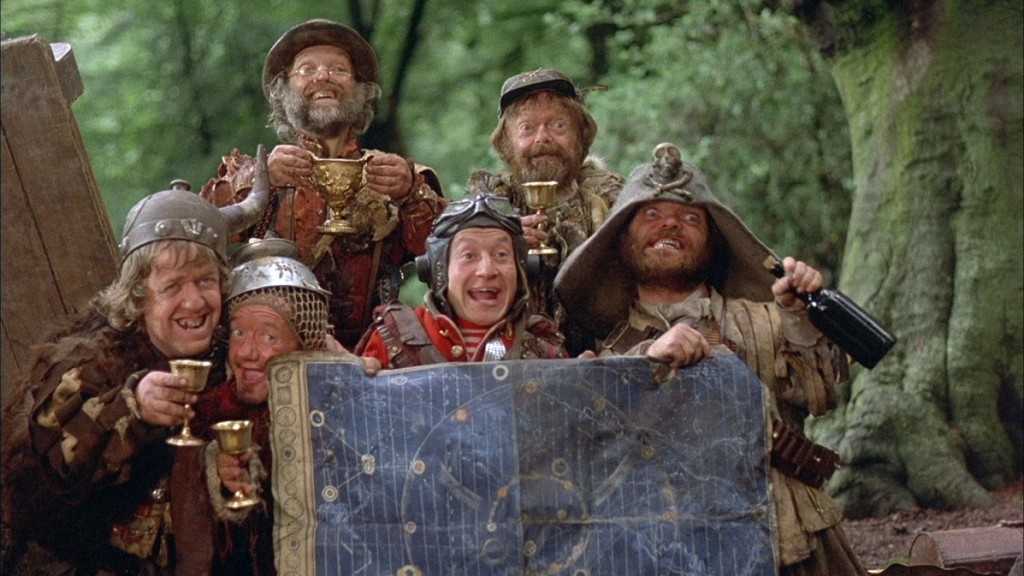 The Time Bandits pose with their ill-gotten gains.
The Time Bandits pose with their ill-gotten gains.
Like Alice in Wonderland, it’s all a bit arbitrary at times, with the film’s main strength to be found in its imagery and set-pieces: Kevin’s bedroom wall extending into an ever-lengthening hallway, or the dwarfs escaping a hanging cage through an elaborate series of swinging ropes.
Ultimately it’s a surprisingly unsettling movie with an ambiguous message. Is Kevin better off for having had his adventures? Was there any point to them at all? What’s he going to do at the end of the film, left with no parents and a burnt-down home? And should what is ostensibly a children’s movie even be asking these questions of its audience?
This more than anything makes it a film worth the watching.
.
Next Time:
We continue to move away from the strict definition of “fantasy films” with Highlander, which today’s more expansive terminology might classify as a time-slip urban fantasy adventure. Conner MacLeod is an immortal, caught up in a centuries-long competition with others like him that can only end with one left standing. As the tagline says: “there can be only one.”
.
About The Reviewer:
 Rebecca Fisher is a graduate of the University of Canterbury with a Masters degree in English Literature, mainly, she claims, because she was able to get away with writing her thesis on C.S. Lewis and Philip Pullman. She is a reviewer for FantasyLiterature.com, a large website that specializes in fantasy and science-fiction novels, as well as posting reviews to Amazon.com and her They’re All Fictional blog.
Rebecca Fisher is a graduate of the University of Canterbury with a Masters degree in English Literature, mainly, she claims, because she was able to get away with writing her thesis on C.S. Lewis and Philip Pullman. She is a reviewer for FantasyLiterature.com, a large website that specializes in fantasy and science-fiction novels, as well as posting reviews to Amazon.com and her They’re All Fictional blog.
To read Rebecca’s detailed introduction of both herself and the series, as well as preceding reviews, click on:
Big Worlds On Small Screens
Rebecca won the 2015 Sir Julius Vogel Award for Best Fan Writer, for writing that included Big Worlds On Small Screens.


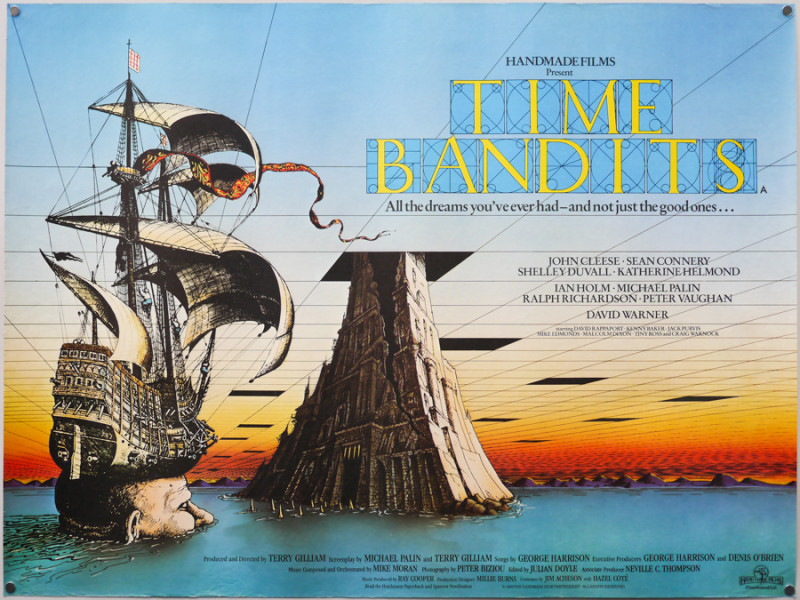
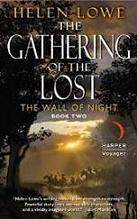
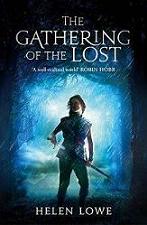
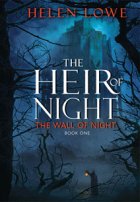
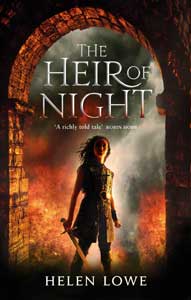


Oh that dark ending was so weird the first time I saw the movie.
I can attest that my first reaction was also: “Buh? What just happened?”
Hi Ms Fisher (and Ms Lowe), I hope you don’t mind me asking you a (rather lenghty) question here, but I can’t comment on your own “They’re All Fictional”, so I decided to do it here.
I just watched the first season of “Supergirl”, my first steps into superhero fiction. I had hoped to, after I’d finished it, start watching some or other Superman TV series/movie. (I actually assumed that “Supergirl” was some kind of spin-off based on a Superman series, only it wasn’t, and I got stuck.) To make matters even more complicated, one episode was a cross-over featuring the Flash – which put the Arrowverse into the equation – and now I really have no idea at all where to start, with all the Superman & Arrow series/movies there are.
Since I assume you have watched one or two or more of those (both the entire Superman franchise and the Arrowverse), I was wondering if I could ask you for some advice on what series/movie(s) I should start with. That way, I could slowly get more familiar with the worlds and ‘verses’ and find my own way in it. But for now, some help would be highly appreciated. To be clear here: At this point, I’m not really interested in all the comics and such out there. If you decide to help me, you only have to tell me about movies, live-action and animated TV series.
Thanks for your help!
I hope you don’t mind an equally long reply!
A useful term to know when you’re dealing with adaptations of comic books is the word continuities. There are dozens of film/television takes on comic book characters, but not all of them are connected – for instance, Christian Bale and Ben Affleck have both played the character of Batman/Bruce Wayne, but the stories in which they play that character are completely unconnected.
Therefore, we would say that Christopher Nolan’s “Dark Knight Trilogy” and Zack Snyder’s “Batman Versus Superman” belong in different continuities (or “universes”), even though they share the same characters and general premise. On the other hand, the more recent “Man of Steel” and “Batman Versus Superman” ARE in the same continuity, as one is a direct continuation of the other, with the same actors playing the same roles.
Adaptations of DC comic books have many different continuities, though the biggest ones are listed here:
1)
The one you’re probably most interested in is what’s known as the Flarrowverse continuity (a portmanteau name for “Arrow” and “The Flash”). Airing on the CW Network, it originally started with “Arrow” in 2012. The second season of “Arrow” introduced Barry Allen to the show as a guest-star in anticipation for his own spin-off “The Flash”, which started in 2014.
There are occasionally cross-overs between the two shows, with characters from “Arrow” visiting “The Flash” and visa-versa.
Two more spin-offs have recently been added to this continuity. “Legends of Tomorrow” (which features characters from both “Arrow” AND “The Flash”) started in 2016 and an animated webseries called “Vixen” was released in 2015. They star different characters, but all those characters exist in the same universe (or continuity) and occasionally guest-star in each other’s shows.
Now, for complicated legal reasons, characters such as Superman and Batman cannot appear in the Flarrowverse – they can only be alluded to, but never fully shown. This is because Warner Brothers is currently building a film continuity that’s entirely separate from the “universe” that exists in the television shows.
(It’s actually led to some mild tension between the film and show makers – for instance, “Arrow” was starting to build up their own version of the Suicide Squad, and was then forced to dispose of them once the Warner Brothers film started production.)
This brings us to “Supergirl”. It aired in 2015 on the CBS channel and originally was NOT part of the Flarrowverse continuity – it was simply a show about Supergirl which was completely unconnected to anything else. Of course, that changed when Barry Allen/the Flash appeared in a guest starring role. Although it didn’t start out that way, “Supergirl” has retroactively been added to the Flarrowverse continuity – and because the second season of “Supergirl” will air on the CW instead of CBS, it’s likely that more crossovers will occur in the future.
(A similar thing also happened with the show “Constantine”. This was another originally unconnected show based on a DC comics book character, and when it was cancelled in 2014, the “Arrow” writers brought the character – as played by the same actor – in for a guest-starring role on “Arrow”. As with “Supergirl”, his show was retroactively added to the continuity).
Whew, this is really complicated. Are you still with me? 😉
So in order to follow THIS particular continuity, I would suggest starting with season one of “Arrow”. It was the earliest instalment in the Flarrowverse, and from it stems all the other spin-offs (“The Flash”, “Legends of Tomorrow”), bonus web series (“Blood Rush” and “Vixen”) and retroactively-added shows (“Constantine” and “Supergirl.”)
Here is a comprehensive list of all the aired episodes in the correct viewing order: http://www.imdb.com/list/ls074499769/
2.
Next of all, we’ve got what’s known as the DC Animated Universe (or DCAU). This continuity is comprised of several cartoons and animated TV-movies, and though it’s suitable for children, there’s plenty for adults to enjoy as well. As it goes on, the themes and content become much more mature, and by the time you reach “Justice League” the storylines are quite complex.
It started in 1992 with “Batman: The Animated Series” and was followed with “Superman: The Animated Series” in 1996. Although (if memory serves) there were a couple of crossovers between these two shows, it wasn’t until “Justice League” aired in 2001 that the two characters were permanently brought together, along with characters such as The Flash, Wonder Woman, Green Lantern and Hawkgirl in order to form the titular Justice League.
The universe expanded further with “Justice League Unlimited” (which added more DC characters to the show) and spin-offs such as “Batman Beyond” (1999), “Static Shock” (2000) and “The Zeta Project” (2001).
Because they all belong to the same continuity, they can technically be watched in any order without TOO much confusion, though it doesn’t hurt to watch in the order they were aired: Batman – Superman – Batman Beyond – Static Shock – The Zeta Project – Justice League – Justice League Unlimited.
There are also a handful of TV movies that also belong to this continuity: “Mask of the Phantasm”, “Mr Freeze: Subzero”, “Return of the Joker” and “Mystery of the Batwoman.”
3.
Finally, there’s the current DC film franchise that’s being built up much the same way as the Marvel franchise. It started with “Man of Steel” and continued with “Batman Versus Superman”, and is soon to be joined by “Suicide Squad” and films starring Wonder Woman, Aquaman and The Flash (which – because of the new continuity – have nothing to do with either the Flarrowverse or the DCAU).
Some fans disparagingly refer to this continuity as the “Murderverse” because they’re unimpressed with Zach Snyder’s dark vision.
(And of course, there are probably dozens more films and TV shows featuring DC characters which belong to completely separate continuities: Tim Burton’s original Batman movies, or the long-running “Smallville” TV show for example).
I hope this helps you out! It was an extremely lengthy reply, but I love this sort of thing – and the concept of “continuities” and “universes” in fiction gets surprisingly complex!
OK. Wow. That was a much longer reply than I’d even hoped for. Thank you so much for that. Maybe I’ll let you know what I thought of all those series & movies after I’ve finished them – in three years’ time, with a bit of luck :-).
I hope I didn’t go overboard – but you’ve got a lot of good television ahead of you.
Wow, excellent and comprehensive reply, Rebecca: am sure I’m not the only person who found it illuminating and helpful.